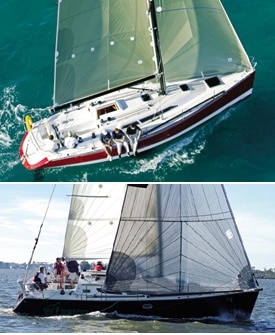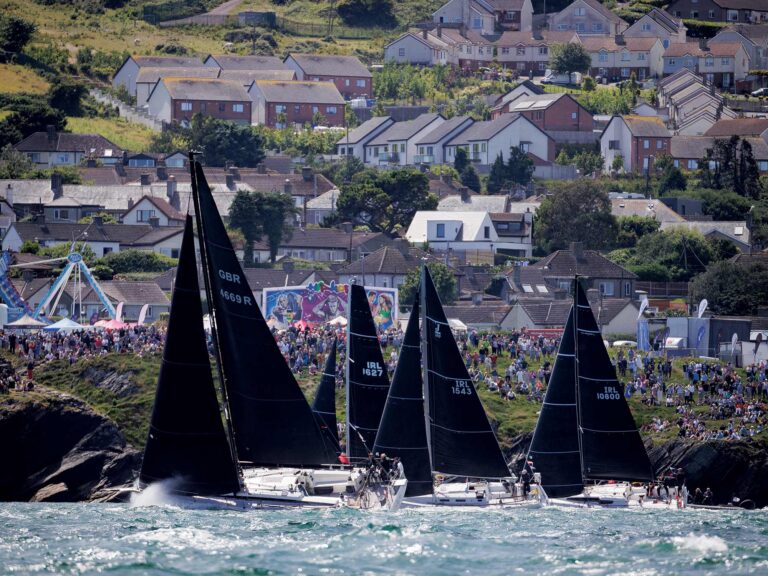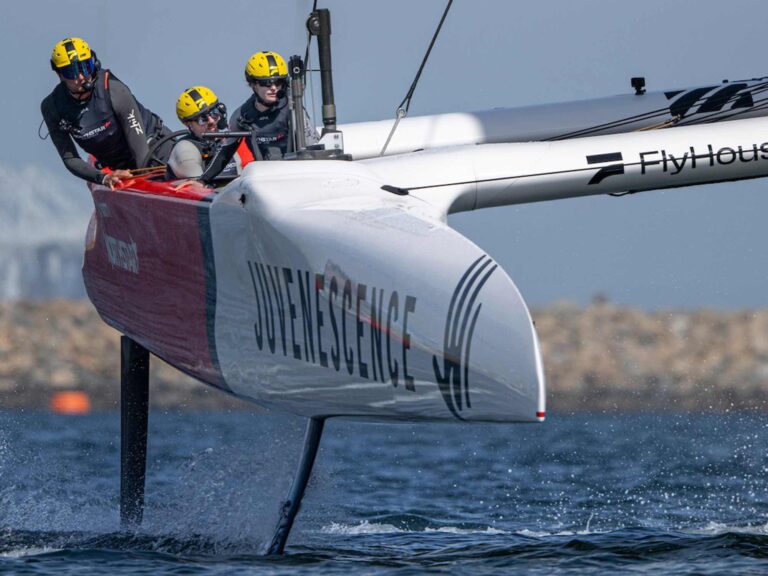
C&C 115, Jenneau San Fast 35
Some people make no distinction between cruiser/racer and racer/cruiser. It’s a matter of semantics to them. A dual-purpose boat is a dual-purpose boat. But we’ve always found that some such boats do have a dominant race personality and some have a more cruising nature. When we saw the C&C 115, we were confident it would live up to its racer/cruiser label and the Jeanneau Sun Fast 35, likewise, a cruiser/racer. But while reviewing the boats, we decided to dig into the details of each and see if we could confirm our first impressions. Racer/Cruiser, the C&C 115 Consider the basic specifications of the new C&C 115. The hull is made of E-glass and epoxy with CoreCell core, and reinforced with carbon fiber in high-load, high-stress areas. The vinylester and e-glass deck is cored with Baltek AL 600, and the mast is a 59’9″ carbon fiber, two-spreader design that carries a near-masthead kite and a 110-percent genoa and weighs one-half of what a comparable metal rig would. The rudder is a high-aspect ratio blade, and a lead bulb sits at the bottom of a deep keel. The transom is open and the deck layout is race-ready. While the boat comes standard with discontinuous rod rigging, jacketed PBO standing rigging is available as an option, which adds surprisingly little to the all-up price. Ten years ago, you would have paid top dollar for such a boat, you’d have had to wait six months for a custom builder to build it, you wouldn’t have been able to afford the carbon rig and you couldn’t even buy the PBO shrouds. Lucky for us, C&C is offering the 115 as a production racer/cruiser that anyone with the cash can step up and buy. It’s clear that Tim Jackett, designer and COO of builder Fairport Yachts, has spent a lot of time on raceboats observing how crews get around a racecourse. The result is a well laid-out boat that’s in line with racing ergonomics. Let’s start with the 115’s toerails, which end just aft of the shrouds, look like they actually deflect water, and seem like they’d be great toeholds during breezy takedowns. Best of all, they won’t dig into the underside of your thighs when you’re hiking. Two Lewmar hatches also grace the bow, the forward most and largest (24″ x 24″) is sized perfectly for spinnaker douses. The side decks are roomy, a result of the 11’11” beam and the fact that the chainplates and jib tracks are tucked in close to the deckhouse. The cockpit is large enough for evolutions such as spinnaker jibes with a full crew. The main trimmer and driver positions are as well placed as anything you’ll see on a custom offshore racer. The C&C 115’s halyards, spinnaker pole controls, and reefing lines all lead from double-stacked organizers at the mast back to Spinlock jammers arranged on either side of the companionway. The companionway is snug enough to keep you safe when big seas are running and large enough to fit a pitman and his octopus act. The Harken winches also seemed to be placed perfectly for every maneuver that you’d see on a racecourse. We sailed the 115 on an atypical Annapolis day; it was blowing 16- to 22-knots, and there was a decent-sized chop on the brown waters of the Chesapeake thanks to some heavy rains the week before. Backing out from a tight raft-up on the Eastport side of the Severn we had an early indication of how well the 115 backs down and how maneuverable the boat is under power, even in awkward situations. We set a full main and a heavy No. 1, both built by Doyle, and started reaching past the Spider buoy to get a clear runway for some upwind sailing. The 37-foot 115 handled extremely well in the big puffs that might’ve spun out many other boats. The rudder is balanced, and while it kept us from cavitating, and allowed us to turn down even without mainsheet ease, we heard some groans and felt some stiffness from bearings that felt as if they weren’t up to the task. Jackett explained the problems: This was the prototype 115 and a custom stainless steel sleeve that was supposed to fit over the carbon rudderpost came from the manufacturer looking more oval than round, plus the bearings they’d used are slated for an upgrade in the production series. Despite these issues, once we were able to get in a groove, the boat steered like a dream with only slight corrections by the helmsman. We averaged between 7.5 to 8 knots upwind, depending upon the wind strength. Once the symmetric spinnaker went up, we started to fly. We saw speeds of up to 10.2 knots and never felt on the edge. In fact, when we had to steer deep to settle a wrap, it was easy to sail max deep and not feel as if we were going to clean everyone out with an accidental jibe. There were only three of us aboard for the test sail, but Jackett thinks a crew of eight will be the call for race days. The 115 we sailed is Hull No. 1, a prototype of the production model, especially as far as the interior is concerned. The interior was part mock-up, made of like-sized C&C interiors, so it was hard to get a feel for how roomy the interior is going to be. We’re told that the 115’s interior is based on what owners of the C&C 110, a seven-year-old model, and the three-year-old C&C 99 told C&C they wanted in future designs. Suggestions included a larger galley, a nav station that faces forward, and an aft berth placed across the boat rather than fore-and-aft. We saw 110-volt electrical sockets everywhere, grab handles, and a high level of fit and finish, especially for a prototype. The price of a C&C 115 ready to sail, with $35, 435 worth of race options, such as Raymarine ST60 instruments, a Horizon VHF with a remote access microphone/speaker in the cockpit, PBO shrouds, carbon spinnaker pole, two Harken winches for spinnaker handling, and high-tech race sails, is $204, 935. We feel that the 115 will be a player on any racecourse and with all these goodies, deserves the label racer/cruiser. But when you see a 115 this summer or at a boat show this fall, you may decide it’s got the interior volume and comfort to be a great cruise platform too. It all depends on whether owners can tear themselves away from the smell of gunpowder. www.c-cyachts.com Cruiser/Racer, the Jeanneau Sun Fast 35 The Sun Fast 35’s hull form was originally introduced as the Sun Odyssey 35, an out-and-out cruiser as comfortable as the day is long, and extremely popular, with well over 300 boats sold since it’s introduction in 2002. Marc Lombard, a French designer who’s had success in the Open 60 class designed the 35, which means that even in Sun Odyssey configuration, it’s got raceboat DNA. In the past, Jeanneau has been successful in taking popular Sun Odyssey models, such as their 37-footer, and turbo-charging them with taller rigs and deeper keels, as well as racing hardware, so when they saw how popular the 35 was, they decided to do the same with it. The Sun Fast 35 uses the same hull, deck, and interior layout as the Sun Odyssey 35, and offers the same large, comfortable interior. Upgrades include a two-foot taller [52′ 8″], keel-stepped aluminum mast on which the wire standing rigging is replaced with discontinuous Dyform rod. The draft has been increased to 7 feet from 6, and the rudder has been lengthened as well. The traveler has been relocated from the cabin top to the cockpit, and an instrument cluster now resides just forward of the sliding hatch over the companionway. The hull construction is old school, but updated technologically and eminently reliable. Jeanneau builds hulls with a resin-injection process, which uses fiberglass and polyester resin, and layers high-stress areas with layers of Kevlar cloth. For stiffness, a structural grid of laminated hardwood is bonded to the hull. The deck is injected with Jeanneau’s proprietary injection system, which the company claims to make light, but strong decks. The Sun Fast weighs slightly more than the Sun Odyssey version, thanks in part to its keel bulb. On deck, Jeanneau has done a lot of things right, especially as far as racing gear is concerned: all the halyards lead back to banks of Spinlock XTS jammers on either side of the companionway, and all the deck gear and winches are Harken. An available option package features a two-groove headstay, a second spinnaker halyard, and a carbon spinnaker pole. The 35 we sailed came with some of its race crew for our test sail, and they showed us how well the deck layout works during maneuvers. The toerail, which runs from bow to stern and will make cruisers feel safe, won’t be popular on a long beat among hiking crews, but the side decks were roomy. A large hatch on the forward part of the deckhouse is plenty big enough for spinnaker takedowns. The cockpit, because of the length of the deckhouse, the traveler, and the optional steering wheel, was crowded during crew-intensive maneuvers such as jibing, so we feel that the tiller, which comes standard, might be a better choice. We used a 155-percent overlapping genoa in the 8-knot breeze and accelerated nicely out of tacks. The steering was light and responsive, a credit to the deeper rudder and keel. When the symmetric spinnaker went up, we were making 6.8 to 7 knots of boatspeed. The interior of the Sun Fast 35 is a space that belies the boat’s exterior dimensions, thanks in part to the large deckhouse. The head is huge, there’s lots of room in each of the two cabins [a three-cabin, two-head layout is an option], and handholds abound. The electrical panel is a cinch to get at, with only four machine screws (which thread into metal sleeves, a nice touch we’d like to see more of) holding it in place. The nav station is to port, with a sliding table, which has the navigator facing aft, sitting on the aft edge of the settee. The roomy L-shaped galley is to starboard and has plenty of counter space. The floorboard’s edges were sealed, an example of close attention to details by the builder. The 27 HP Yanmar is under the cockpit and is accessed by lifting the companionway stairs or removing two side panels in the aft cabins. The engine lives in it’s own fiberglass compartment, which keeps any oil or diesel from escaping to the rest of the bilge. The stainless steel propeller shaft carries a kelp cutter just forward of a folding, two-blade prop. In our engine test, the boat backed down in a well-mannered way. We saw 6.7 knots on the speedo at 2,800 rpm in forward and engine noise was only moderate. So is the Sun Fast 35 a cruiser/racer? For some, the cruiser surely comes first due to the boat’s proven accommodations and interior systems, but with its long waterline, deep appendages, and medium-tech construction, the 35 rates well in IRC and is likely to surprise with its speed. At a price of $180,596, loaded with performance sails, carbon spinnaker pole, Tuff Luff, and instruments, this boat could well be a chameleon, capable of putting either personality-race or cruise-first. www.jeanneauamerica.com









